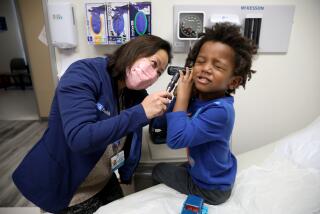‘We do accept Med-a-Bear and all HMOs.’
- Share via
The director of the emergency department at Nu-Med Regional Medical Center in Canoga Park was hunched over an operating table, stitching stuffed animals.
The patients came one after another, cradled in the arms of little children. A stuffed cat with a broken leg. A mouse with a missing nose. A splint here, a bandage there.
For nine hours, Dr. Michael Weiner toiled with his fellow doctors and nurses in two critical care rooms at the second annual Teddy Bear Clinic--the hospital’s effort at familiarizing youngsters with the emergency room in case they ever have the misfortune to be there as patients.
“Accidents,” explains Nu-Med spokeswoman Nancy La Sota, “are the No. 1 killer of children.”
Four-year-old Matthew Ford looked fine, if slightly wary, as he shuffled into the hospital on Friday. He clung to his mother with one hand and to his injured friend, Raggedy Andy, with the other. Together, they edged toward the emergency room.
Bill Scherer, a resident physician on duty, stood behind the surgical table trying to assess Andy’s problem. After a few long, silent moments, Matthew lifted his eyes from the floor, gently set his doll on the table and told the doctor, in a voice so soft it was barely audible, “His eye’s broken.”
With that, Scherer spun into action. He reached for his scissors and suturing material and, within minutes, Andy sported a new, shiny, green button for an eye. Matthew stood motionless all the while, gripping his pal’s hand and watching the doctor’s every step.
“How’s he doing?” Scherer asked.
“Lookin’ good,” Matthew replied.
When the surgery was complete, Matthew picked up his doll and carefully inspected its new eye. It didn’t quite match the old one, which was black. But Matthew didn’t seem to mind. He held it tightly to his chest, then turned and walked away.
All told, about 300 children, with stuffed animals of every size and shape and variety, tromped through the hospital for the Teddy Bear Clinic. Not bad for a day’s work. The emergency room generally gets only three times that number, or 900 patients, in an entire month.
In addition to free repairs, the children received an introduction to emergency room procedures, courtesy of Linda Kerner, nursing coordinator for the department.
She led them down a sanitized hallway, into another sterile room where electrodes, oxygen masks, heart monitors and IVs were either displayed on a table or hooked up to dolls. Educational, yes. Cheerful, no.
The Teddy Bear Clinic is one example of increasing public relations efforts, not only at Nu-Med, but at hospitals countywide. Reeling from budget reductions and a growing number of indigents who require care they are unable to pay for, hospitals find themselves competing for paying patients.
“Market research indicates that the more familiarity people have with an institution, the more likely they are to return,” said David Langness, a spokesman for the Hospital Council of Southern California.
So medical centers are sponsoring everything from 10K runs and free cholesterol testing to dances for senior citizens and alcohol-free discos for teen-agers.
“They are looking for innovative ways that they can reach out to the community rather than spending millions of dollars on advertising,” Langness said.
The Teddy Bear Clinic, La Sota said, was devised with the hospital’s adopted school, Nevada Avenue Elementary, in mind.
In some ways the clinic resembled a real emergency room. Patients occasionally had to wait a long time, and they got impatient. At one point a Nevada Avenue student vented his frustration. “I have to be next,” he shouted. “My bear is bleeding.”
Weiner, a jovial man with round, pink cheeks and an easy smile, seemed to delight in showing visitors his kingdom.
“These are our replacement parts,” he said, displaying a plastic bag stuffed with buttons of assorted sizes, shapes and colors. “We have eyes, noses and belly buttons. Some are anatomically correct, some not. We do accept ‘Med-a-Bear’ and all HMOs.”
Jonathan Alvanos, 8, didn’t seem concerned about insurance when he entered the clinic.
“What’s up with him?,” Weiner asked, fixing his eyes on the animal in Jonathan’s hand.
Jonathan kept his response brief.
“Nose,” he replied.
“What happened to it?”
“My dog was nibbling on it.”
Gregory Guillen, 2 1/2, had a similar problem with his Mickey Mouse doll, but the blame for the injury did not lie with a pet.
“I bit it off,” Gregory confessed.
Nine-year-old Emily Keegan and her teddy bear were among the last patients of the day.
“Who brought this bear here?” Weiner demanded. “This bear is fine. I think you’re the sick one,” he said, peering down at Emily and proceeding to wrap her head in gauze.
More to Read
Sign up for Essential California
The most important California stories and recommendations in your inbox every morning.
You may occasionally receive promotional content from the Los Angeles Times.










